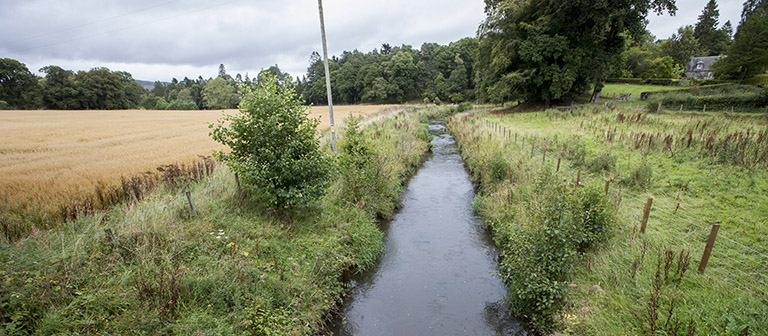Community management model helping to protect rural residential properties and prime farmland

Plans progress to update governing legislation of 13th century drainage channel
A valued communal resource, helping protect over 2,000 acres of some of Scotland’s most fertile agricultural land and adjacent residential developments from flooding, is set to benefit from legislative reforms that will enable those responsible for its maintenance and management to more effectively service the community.
The Pow of Inchaffray is a drainage channel in Perthshire, tracing its origins back as far as the 13th century. Today, it is maintained by the Pow of Inchaffray Drainage Commission.
The Commission’s role remains to work to prevent flooding of low-lying land in Strathearn, but its work has also made residential development possible. It is therefore important to local heritors (occupiers of land) that the Pow continues to be maintained to prevent flooding in this area.
ADA, the membership organisation for drainage, water level and flood risk management authorities, has been supporting the ongoing work of the Pow of Inchaffray Drainage Commission as it progresses with updating its governing legislation, which is currently before the Scottish Parliament as a Private Bill.
These reforms will enable the Commission to continue to manage and maintain vital drainage channels that flow into the River Earn, near Crieff in Perthshire.
The original legislation was some of the oldest known in the whole of the UK and the job of bringing it up-to-date recognises the important connection between those that own and look after the fertile land in the Pow of Inchaffray, and those with houses adjacent to the Pow who benefit from its good management and maintenance by the Drainage Commission.
This model of community management has clearly stood the test of time and ADA is proud to represent a growing trend for local support from this kind of organisation. There are examples of similar working arrangements, but having sound legislation in place ensures a good, democratic and fair management of an area’s water level management. People are increasingly willing to engage with a low-cost service that provides a direct benefit to them which they might not otherwise be able to receive from central or local government.
Innes Thomson, ADA’s Chief Executive said “It’s great to see the Pow of Inchaffray Commission coming into the public limelight for the good work that it does in protecting people, businesses and the environment from flooding. With Councils increasingly under pressure on the services they can provide, this could be an excellent opportunity for other low-lying areas of Scotland to consider similar operating models to manage and maintain drainage systems”
Archive
- April 2024
- March 2024
- January 2024
- December 2023
- November 2023
- October 2023
- September 2023
- August 2023
- July 2023
- June 2023
- May 2023
- April 2023
- March 2023
- February 2023
- January 2023
- December 2022
- September 2022
- August 2022
- July 2022
- June 2022
- May 2022
- April 2022
- March 2022
- February 2022
- January 2022
- December 2021
- November 2021
- September 2021
- July 2021
- May 2021
- March 2021
- February 2021
- January 2021
- December 2020
- November 2020
- October 2020
- September 2020
- August 2020
- July 2020
- May 2020
- April 2020
- March 2020
- February 2020
- January 2020
- December 2019
- November 2019
- October 2019
- September 2019
- August 2019
- July 2019
- June 2019
- May 2019
- April 2019
- March 2019
- February 2019
- January 2019
- December 2018
- November 2018
- October 2018
- September 2018
- August 2018
- July 2018
- June 2018
- May 2018
- April 2018
- March 2018
- February 2018
- January 2018
- December 2017
- November 2017
- October 2017
- September 2017
- August 2017
- July 2017
- June 2017
- May 2017
- April 2017
- March 2017
- February 2017
- January 2017
- October 2016
- September 2016
- August 2016
- July 2016
- June 2016
- May 2016
- April 2016
- March 2016
- January 2016
